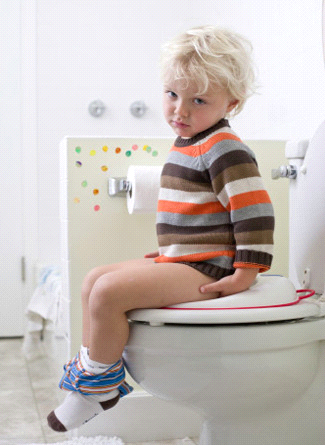
CONSILENCE IN CHILDREN
Constipation, which is defined as difficulty or delay in defecation in its simplest definition, is a common ailment in infants and children. Babies’ poop habits can be very different. Normally, some babies can poop 6-7 times a day, as well as once every 4-5 days. The frequency of defecation decreases with age. Breastfed infants should have at least 2 defecations per day, mixed fed infants should have at least 3 defecations per week, and older children should have at least 2 defecations per week. Constipation is not common in breastfed babies. Constipation is more common in babies who take cow’s milk or formula.
The frequency of defecation varies between 3 times a day and 3 times a week in the majority of children aged 3-4 years. Accordingly, the definition of constipation is expressed as the habit of defecating less than 3 times a week. However, stool consistency and painful defecation are important findings. A child who defecates once a day but has a very painful and hard poo should also be considered constipated. In order to say constipation, one or more of the findings such as the baby or child not pooping outside of their normal frequency for a few days, hard poop, goat pooping, swelling in the abdomen, difficulty in pooping and fresh blood should be present. Reddening of the child’s face while pooping in a normal consistency is not considered as constipation.
Encopresis is defined as the voluntary or involuntary leakage of solid, soft or liquid stools to a place other than the toilet. It is mostly caused by chronic constipation, but sometimes encopresis can occur without constipation. Incontinence is usually seen in boys between the ages of 6-10. It may be due to psychological or organic causes. In these cases, besides the treatment of constipation, psychological support is also required.
CAUSES OF CONSILENCE:
In more than 95% of children, the cause is functional and there is no structural disorder.
1. Feeding the mother with a diet that predominantly causes constipation in breastfed infants.
2. The child does not get enough nutrients, does not take fiber (pulp) foods or drinks less water.
3. Some infectious, metabolic and hormonal diseases (such as hypothyroidism).
4. Transition to complementary foods and teething.
5. Inactivity in infants and children.
6. Reluctance to go to the toilet.
7. Fear of the toilet, early toilet training or psychological constipation may develop in children of irritable and nervous mothers
8. Congenital absence of sufficient nerves in the intestines (Hirschprung’s disease).
TREATMENT OF CONSILENCE:
First of all, it should be known that there is no constipation that cannot be treated. However, the treatment of constipation can sometimes be with a change in diet, and sometimes it may require a series of operations. The most important point here is that the family does not think that ‘we went to the doctor, we got a prescription, the disease will be cured by using only the drugs’. The treatment requires a process and during this period the doctor and the family should be in close communication. The sooner the treatment is started, the better the result. The medical and psychological approach should be together.
During the treatment process, *Diet, *Education, *Medical-Drug treatment *Communication and harmony are essential.
Establishing trust with the family, explaining the defecation mechanism and educating the patient constitute the first and most important step of the treatment. In the meantime, necessary dietary changes should be made. Drinking a glass of water on an empty stomach every morning, even if the feeling of defecation does not occur after each meal, it is important for toilet training to go to the toilet and sit for 5-10 minutes. Most of the patients are diagnosed with treatment at this stage. Medical treatment should be considered in chronic constipation that does not respond. For this, first of all, hard poops in the abdomen should be emptied, and then maintenance treatment should be started to prevent them from reoccurring and to defecate regularly. In maintenance treatment, it is necessary to continue the treatment given according to the doctor’s advice for at least 6 months.
1. Plenty of fluids should be given.
2. Body exercises can be beneficial for young babies.
3. Constipation foods in Table 1 should be avoided.
4. It should be given more than the foods that prevent constipation in Table 2.
5. If constipation is observed when switching to a new formula, the formula should be changed.
6. Cow’s milk should be discontinued during the treatment.
7. The child should be placed on the toilet at a certain time (breakfast and after dinner) every day, without delaying the need for the toilet, and he should gain the habit of toilet.
8. Keeping a diary to mark the number of stools per day and, if any, stool incontinence is encouraging in the child and is important for the follow-up of the treatment.
9. The problem should be tried to be solved by encouraging the child, not by punishing them.
The child with constipation hurts while pooping because his poop is hard, and therefore he does not want to poop. However, if you do not poop, the poop becomes hard and causes more discomfort when you poop. The aim of treatment is to break this vicious circle. In children who have a lot of hard and petrified poop in the large intestine, giving oral poop can cause abdominal pain, cramping, bloating and vomiting. Therefore, in such children, first of all, stool should be emptied from the rectal route. Then, as a maintenance treatment, oral easy-to-poop drugs should be given. The amount of fiber taken daily is increased. For proper toilet training, the child should be brought to the toilet after meals in the morning and evening, and it should be ensured that he sits on the toilet for at least 10 minutes.
Table 1: Constipation-Causing Foods:
1. Banana, cranberry and apple juice, quince, carrot, chestnut,
2. Potato,
3. Pasta, rice pilaf, chocolate, chips, nuts,
4. Formula foods,
5. Dough foods,
6. Fast food style foods.
7. Cola caffeinated drinks, acidic and carbonated drinks…,
8. Cow’s milk
9. Sausage, salami, sausage, pastrami…,
10. Spleen, tongue, rumen, brain, kokoreç, liver…,
11. Margarine, butter…,
Table 2: ANTI-constipation foods:
1. Cabbage, celery, leek, okra, artichoke, broccoli, cauliflower, beans, zucchini, cucumber
2. Legumes such as beans, lentils, peas, chickpeas
3. Apple, pear, plum (especially damson), apricot, grape, peach, cherry
4. Whole wheat flour, rye flour, oat flour, corn flour
5. Extra virgin olive oil , corn oil, soybean oil, hazelnut oil
“Constipation IS A TREATABLE DISEASE”
Target; To treat constipation without the consequences of encopresis (poop incontinence) and enuresis (incontinence), to give the child the habit of eating for a healthy future.
Pediatric surgeon, Op. Dr. ZAFER DORTDOĞAN

